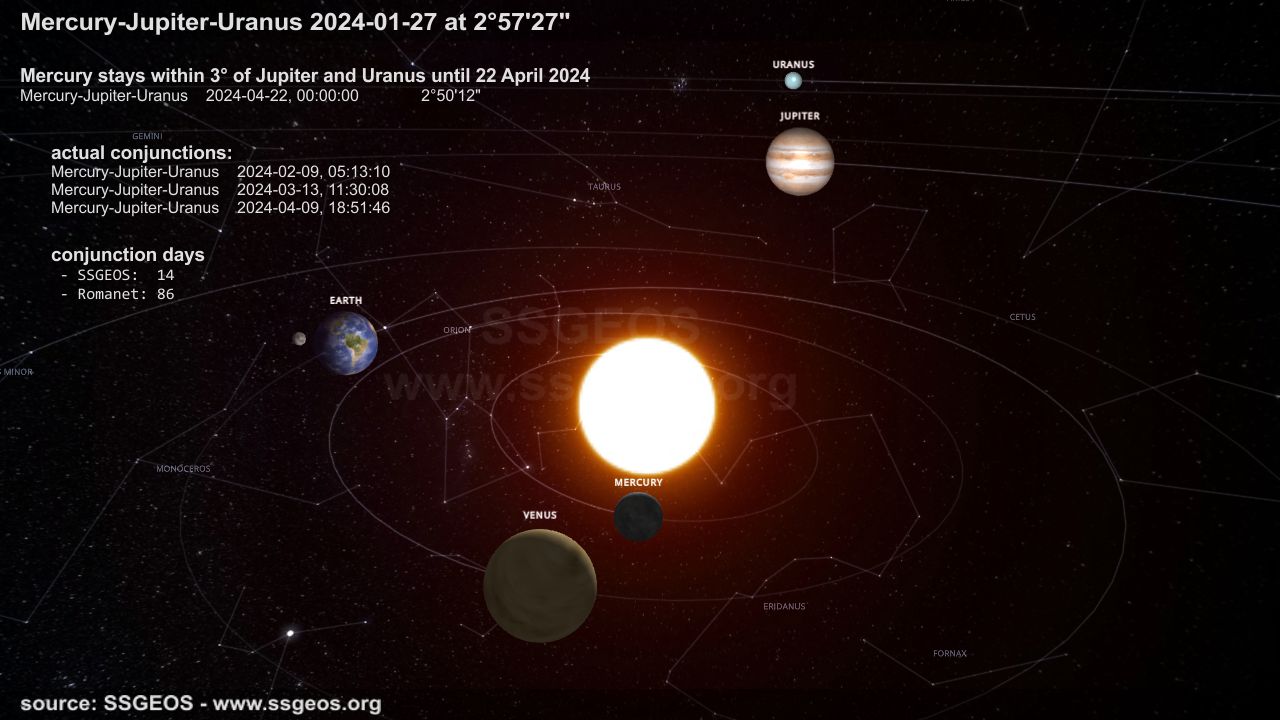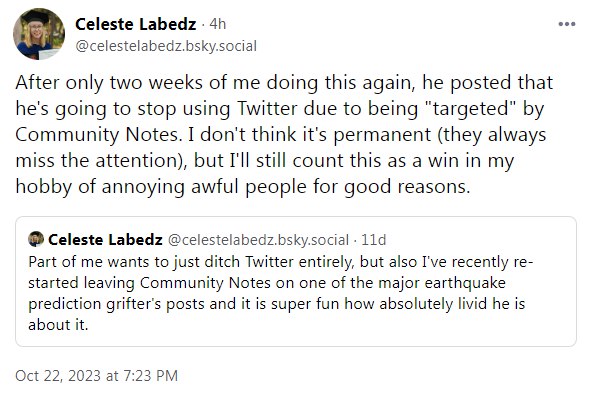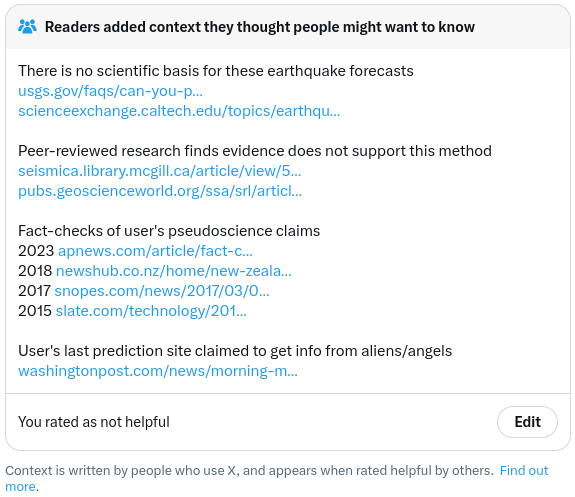Community Notes on X/Twitter
last updated 12 August 2024
1. Scientific Basis
2. Peer-reviewed Research
3. Fact-checks
4. Aliens/Angels
Note author Celeste Labedz
Since the major earthquakes in Turkey on 6 February 2023, a seismic potential that was emphasized by our CEO Frank Hoogerbeets in a tweet three days earlier, our accounts on X/Twitter have been a continuous target of community notes claiming that "there is no scientific basis for these earthquake forecasts." These notes have often been rated as citing "high quality sources." On X/Twitter we have repeatedly stated that these notes are actually of low quality citing sources exclusively from the United States, a country that is known for being very conservative in the field of seismology. In Asian countries there has been much more progress, especially in the field of ionosphere-lithosphere coupling (atmosphere-crust connection), a relationship largely rejected by United States seismologists. Thus, the community notes should be seen in light of the conservative attitude primarily coming from the United States.
Article continues below the image.
First of all, let's address the purpose of X/Twitter's community notes. They are supposed to target potentially misleading posts. In the case of the SSGEOS, none of our posts are misleading. Our research, models and statistics are documented and open for research to anyone. It is telling that none of the cited sources in the community note actually disprove or even address the models and statistics that we use. So let's break down the four sections of this repeatedly copy-pasted community note.
1. "There is no scientific basis for these earthquake forecasts"
In this section the first source links to a text on the USGS website. The first line of that text states that: "No. Neither the USGS nor any other scientists have ever predicted a major earthquake." This is incorrect. In October 1989 USGS geologist Jim Berkland predicted an earthquake in California based on specific signs in the region. Four days later the Loma Prieta earthquake occurred. After his correct prediction Berkland was suspended because he was not allowed to make earthquake predictions in his capacity as a USGS scientist.
In the text the USGS goes on to explain that in order for a prediction to be valid, three key elements must be included, which are time, location and magnitude. It is important to realize that it is the USGS that sets these requirements. Not even weather forecasts are required to have this level of precision. As with the weather forecast, we believe that it is acceptable to forecast a greater potential, say 60% or 70%, for a major earthquake in the next 2-3 days, if the forecast is based on established models, as we have developed at the SSGEOS in recent years.
The second source links to a text from Caltech explaining more about earthquake probabilities and forecasts from their point of view.
It is important to understand that neither of the first two sources addresses models that include positions of the Sun, the planets and the Moon at the time of larger earthquakes. This is crucial, because in recent decades no comprehensive study has been done in this field and there is almost no literature about this subject, which is suspiciously absent from the scientific community. A quick look at our about page that explains why and how the research started, will tell anyone with common sense the significance of such modeling and how erroneous scientists are in automatically rejecting it, simply because they regard the research approach itself as unscientific.
2. "Peer-reviewed research finds evidence does not support this method"
This section of the community note claims to provide evidence against our method by citing two peer-reviewed sources.
One source, a paper by Susan E. Hough addresses the question if large earthquakes occur on "preferred days of the calendar year or lunar cycle." However, this question has never been part of our research, nor is it in any way part of our method or forecast models. There is no good reason for the community note author to cite this paper, other than to deliberately mislead contributors and readers and discredit the SSGEOS.
The other source, a paper by Pierre Romanet addresses the question if planet/sun conjunctions can be used to predict large (moment magnitude ≥ 7) earthquakes. Again we emphasize that limited, superficial research has little meaning. This also applies to this paper. Here we list six key points to consider regarding this paper:
- The author is a seismologist and not an expert in planetary geometry. Unsurprisingly, he does not distinguish between critical and non-critical geometry; he incorrectly assumes that any conjunction should be a major earthquake trigger. This assumption is false. Given the fact that this paper has been peer-reviewed, those who reviewed it are obviously no experts in this field either.
- Planetary geometry is matched against magnitude 7+ earthquakes only. Seismic response in the form of temporal clustering of strong earthquakes, which is equally significant, is ignored.
- A huge conjunction tolerance of +/- 3°(!) is used. Apparently, the author did not make any effort to refine this tolerance (SSGI models use a tolerance of 0.17°). To illustrate how bad this rough approximation of 3° is, we apply it to a Mars-Sun-Saturn conjunction (which is by no means critical, but it is included in the paper results), which would add a whopping 18 conjunction days to the total that serves as proof in the paper. If this conjunction were critical (which it is not) we would mark at most about 4 days following the conjunction as critical. But it gets much worse when outer planets reach a conjunction with the Sun and Mercury moves within 3° of them, such as in early 2024, when Mercury stayed within 3° of Jupiter and Uranus from 27 January to 22 April. See image below. Using a 3° tolerance the peer-reviewed method adds 86(!) days to the conjunction day-count, whereas in reality Mercury is in actual conjunction with Jupiter and Uranus only three times (9 Feb, 13 Mar, 9 Apr), accounting for no more than 3 actual conjunction days and 9 to 14 critical days by SSGEOS standards.
- Convergence of specific planetary conjunctions, as well as temporal clustering of stronger (M ≥ 5.5) earthquakes, both of which are very significant, are not taken into account. Stronger earthquakes more often ten to occur in temporal clusters rather than on average.
- Our SSGI models are not addressed, even though they consistently show an obvious relationship between specific planetary geometry and stronger seismic activity.
- On page 2 in the first column of the peer-reviewed paper it is claimed that there is no mechanism for planetary/sun alignments "because the electromagnetic and gravity fields due to celestial bodies other than the Sun and moon are usually extremely small when they reach the Earth." However, the paper does not provide any research based evidence i.e. statistics or measurements for this claim. And this is the very problem with the leading consensus that planets have little to no influence. This consensus is based on assumptions and conviction; it is not supported by any comprehensive study of planetary positions near the time of large earthquakes. Observation and research are part of the scientific method. Assumption and conviction is pseudo-science.
Observation and research are part of the scientific method. Assumption and conviction is pseudo-science.

It is important to realize that Romanet did not inquire as to our forecast models, in particular the geometry between specific planets, the Sun and the Moon that we emphasize. He simply made several assumptions on which he then based his paper, which is the result of just three weeks of research in March 2023. By contrast, the models that we use are based on nine years of research and software development. If you think about it, it is amazing how quickly and easily Romanet's paper was accepted and peer-reviewed.
Here we touch on a major issue in science regarding the influence of the planets, a debate that has been going on for decades if not centuries. Claims that planets have no influence are usually backed by assumptions and reasoning based on the theory of classical mechanics, rather than actual observation and research. Superficial, limited research as done by Romanet is already rare. In-depth, long-time research as we do at the SSGEOS, is virtually non-existent.
3. "Fact-checks of user's pseudoscience claims"
This section provides the so-called "fact-checks" of our "pseudoscience". The cited sources are carefully selected mainstream media articles, which are not fact-checks at all. At best they present expert opinion. No evidence is presented against our forecast methods (which are not pseudoscience, as they are based on careful observation, measurement and research). We could easily select mainstream media articles that actually confirm our forecasts. It is generally called cherry-picking. Mainstream media do not have authority, nor are they in any position to "fact-check" science.
To illustrate how manipulative mainstream media can be, we take the 18 May 2015 article from Slate, that states: "No, a Planetary Alignment on May 28 Won’t Cause an Earthquake." It addresses the second ever forecast by our CEO Frank Hoogerbeets, in which he expressed his concern about the final days of May 2015 due to a convergence on 27 May of critical planetary conjunctions, which he recognized from his initial 2014-2015 study. Media outlets were quick to dismiss the forecast as pseudoscience. But when a magnitude 6.8 earthquake occurred in Alaska on 29 May, followed by a magnitude 7.8 earthquake (initially estimated 8.5) on 30 May south of Japan, the media were silent and did not refer back to the forecast. Hoogerbeets' first ever forecast covered the magnitude 7.8 earthquake in Nepal on 25 April 2015. Anyone can read about the why and how of this research!
4. "User's last prediction site claimed to get info from aliens/angels"
This is the final section of the community note. It claims that the user's last "prediction" site claimed to get "info from aliens/angels.", citing a Washinton Post article from 2015. However, the SSGEOS was founded and its first and only website created in June 2022. Here we sense the same kind of motivation from the note author to add a "calendar days" method as evidence. These claims really have nothing to do with SSGEOS research, past or present!
Overall, this community note tells us that the author does not care about accuracy, but rather makes every attempt to discredit and ridicule our research and the forecast models that we developed. None of the cited sources address these models or SSGI in general. No comprehensive study is provided that matches our own. This is because ou research is unique; it has not been done by anyone in recent decades.
A recent (May 2024) proposed note from the same author refers to three peer-reviewed sources, two of which are the ones discussed above. The third source however, is not a peer-reviewed paper at all. It appears to be a section of a FAQ list on a web page from Berkeley, which likeswise emphasizes leading scientific opinion; it does not provide research based evidence. It makes the peer-reviewed research section of these community notes very weak and highly misleading.

another misleading X/Twitter proposed community note by Celeste Labedz
Note author Celeste Labedz
On 22 October 2023 seismologist Celeste Labedz (Postdoc UCalgary PhD Caltech) revealed herself on Bluesky as X/Twitter community note author "Jazzy Sandalwood Penguin". In her posts she explained her motivation as "my hobby of annoying awful people" and "it is super fun". This is not the professional behavior one would expect from a scientist. We released this information in a thread on X/Twitter where we explain how Dr. Labedz has been ignoring our statistics and data since March 2023. Since our publication she has locked her X/Twitter account and removed the posts from her Bluesky time line.

Dr. Celeste Labedz on Bluesky explaining her community notes targeting SSGEOS
It is important to understand that all sources selected by Dr. Labedz reflect United States based opinions and do not provide a balanced view of an international scientific community. Much more progress is made by scientists from other countries. Scientists from all over the world, including, seismologists, geologists and meteorologists, follow our research with growing interest. Some sources in the community note are irrelevant or unrelated, thus misleading and deliberately added in an attempt to discredit the SSGEOS. Other sources express opinion. Neither the peer-reviewed papers nor the mainstream media "fact-checks" disprove our statistics and models. In fact, these models, in particular SSGI, which are based on years of observation and research, are not addressed at all. They are simply ignored and disregarded as "pseudoscience" without providing any form of research-based evidence. A comprehensive study that conclusively disproves our models and statistics does not exist, because no similar research and modeling has been done in recent decades.
Obviously, Dr. Labedz' claim that "there is no scientific basis for these earthquake forecasts" is false. Unfortunately, X/Twitter does not actively check or control their community notes. Anyone with a specific (especially scientific) opinion that is supported by a sufficient number of people can target unwanted content with community notes, even if these notes contain irrelevant, unrelated, misleading or even false information, as long as the content does not violate X/Twitter's terms of service. This policy opens the door to harassment and misuse of community notes as we have witnessed since the Turkey earthquakes.
